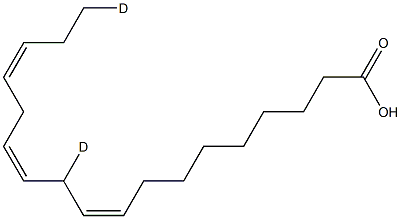Balixafortide
Modify Date: 2025-08-26 02:21:15

Balixafortide structure
|
Common Name | Balixafortide | ||
|---|---|---|---|---|
| CAS Number | 1051366-32-5 | Molecular Weight | 280.441923556 | |
| Density | N/A | Boiling Point | N/A | |
| Molecular Formula | C80H112N22O21S2 | Melting Point | N/A | |
| MSDS | N/A | Flash Point | N/A | |
Use of BalixafortideBalixafortide (POL6326) is a potent, selective, well-tolerated peptidic CXCR4 antagonist with an IC50 < 10 nM. Balixafortide shows 1000-fold selective for CXCR4 than a large panel of receptors including CXCR7. Balixafortide blocks β-arrestin recruitment and calcium flux with IC50s < 10 nM. Balixafortide is also a potent hematopoietic stem and progenitor cell (HSPC) mobilizing agent. Anti-cancer effects[1][2]. |
| Name | 11-Dideuterolinoleic acid |
|---|
| Description | Balixafortide (POL6326) is a potent, selective, well-tolerated peptidic CXCR4 antagonist with an IC50 < 10 nM. Balixafortide shows 1000-fold selective for CXCR4 than a large panel of receptors including CXCR7. Balixafortide blocks β-arrestin recruitment and calcium flux with IC50s < 10 nM. Balixafortide is also a potent hematopoietic stem and progenitor cell (HSPC) mobilizing agent. Anti-cancer effects[1][2]. |
|---|---|
| Related Catalog | |
| Target |
CXCR4:<10 nM (IC50) |
| In Vitro | Balixafortide potently inhibits pERK / pAKT signaling in the lymphoma lines Namalwa (IC50< 200 nM) and Jurkat (IC50 < 400 nM). Balixafortide efficiently blocks SDF-1 dependent chemotaxis of MDA MB 231 breast cancer cells (IC50 < 20 nM), Namalwa and Jurkat cells (IC50 < 10 nM)[1]. |
| In Vivo | Balixafortide is optimized for favorable mouse absorption, distribution, metabolism and excretion (ADME) properties with balanced plasma protein binding, greater plasma and microsomal stability[1]. |
| References |
| Molecular Formula | C80H112N22O21S2 |
|---|---|
| Molecular Weight | 280.441923556 |
| InChIKey | OYWQJZAVFWOOBF-WBMPNIIXSA-N |
| SMILES | CC1NNC(Cc2cnc[nH]2)C(=O)NC(Cc2ccc(O)cc2)C(=O)N2CCCC2C(=O)N2CCCC2C(=O)NC(CCCCN)C(=O)NC(CCC(N)=O)C(=O)NC(Cc2ccc(O)cc2)C(=O)NC2CSSCC(NC1=O)C(=O)NC(CO)C(=O)NC(C)C(=O)N1CCCC1C(=O)NC(CCN)C(=O)NC(CCCNC(=N)N)C(=O)C(=O)C(Cc1ccc(O)cc1)NC2=O |